
- TOP>
- Protect>
- Efforts of JNCAP>
- Car Assessment>
- Collision safety performance>
- Collision Safety Performance Tests


Passenger cars are designed with a structure and the equipment to reduce the degree of injury to passengers in the event of a collision. The method of testing used to evaluate these features must ensure that collision simulated is as realistic as possible and that the data obtained from the tests is highly reliable.
In this test, dummies are placed in both the driver’s and front passenger’s seats and the vehicle is made to collide with a concrete barrier at a rate of 55 km/h. Until fiscal 2017, the dummy on the passenger seat was tested with a dummy simulating a male,From FY2018, the dummy on the passenger seat has been changed to a dummy that simulates a small woman.
The dummies are checked for injuries to the head, neck, chest and legs, the vehicle is checked for damage and deformation, and the results are used to evaluate the degree of passenger protection in 5 levels. This collision test has to simulate the accident at a speed of 55 km/h. Most of actual collisions occur at the speed lower than that of this test. Note that the results of this may not apply to collisions at extremely high speed, when occupants are not wearing seat belt or to a large dumper.
Additionally, the results of collision tests may only be used for comparisons with test vehicles of approximately the same mass. This concept also applies to offset frontal collision test.
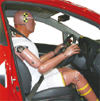
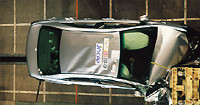
In this test, dummies are placed in the driver’s and rear passenger’s seats and the test vehicle is made to collide head-on on the driver’s side (at an offset of 40%) with an aluminum honeycomb at a rate of 64 km/h. The dummies are measured for injuries to the head, neck, chest, abdomen (rear passenger’s seat only) and legs, the vehicle is checked for damage and deformation, and the results are used to evaluate the degree of passenger protection in 5 levels.
While dummies had been placed in the driver’s and front passenger’s seats until FY2008, a male dummy placed in the front passenger’s seat was replaced with a female one and this female dummy was placed in the rear seat and “Rear Seat Passenger’s Protection for Frontal Collision Performance Evaluation” has been carried out since FY2009.
Because this test involves impact with only one part of the vehicle, the force exerted on the dummy is less than in a full-wrap frontal collision. However, while the full-wrap frontal collision test is well suited to evaluating restraining devices (such as air bags and seat belts)used to protect passengers, in this test there is a significant degree of deformation to the body of the vehicle, which makes it well suited to evaluating aggressiveness to passengers from such deformations.
Note that this test physically simulates offset frontal collision at the speed of 55 km/h similarly to full frontal collision test. Most of actual collisions occur at the speed lower than that of this test.
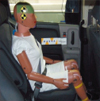

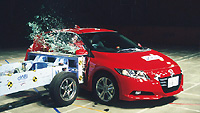
Among the passenger injuries which occur in automobile collisions, side collisions cause the most damage next to frontal collisions. In this test, a sled with a mass of 1,300kg(Until FY2017,mass of 950kg) is made to collide at a speed of 55 km/h with the side of a stationary test vehicle with a dummy normally on the driver’s seat. The dummy is checked for injuries to the head, chest, abdomen, and pelvis, and the results are used to evaluate the degree of passenger protection in 5 levels.
The front of the sled, which has been made to look like a normal passenger car, has also been outfitted with a shockabsorbent aluminum honeycomb which provides a similar degree of hardness as such a vehicle.
In addition, from 2008 to 2017, in case the test vehicle equipped with SCA (Side Curtain Airbag) situation and range of development of the SCA has been evaluated.
This test substitutes pole impact tests of which other NCAPs such as Euro NCAP has carried out.
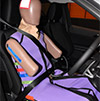
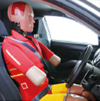
* The side curtain air bag (SCA) has been designed to protect the head of passenger in a side collision, and is generally stored in a roof-rail, etc. In event of side collision, the bag blows open to expand mainly from A pillar to C pillar area along the roof-rail.
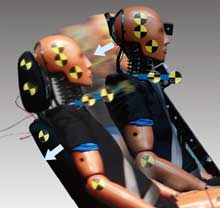
Rear-end collision occurs most commonly among the passenger injuries caused by automobile collisions and most of them are neck injury.
In this test, using a test device, rear-end collision shocks (velocity change (ΔV), wave shape, etc.) are given to dummies placed in the driver’s or front passenger’s seats. The degree of neck protection performance is judged on a scale in 5 levels based on the shock the neck suffered.
This test reproduces rear-end collision impact when a car crashes into a parked car which is the same in mass at a rate of around 36.4 km/h (velocity change (ΔV) of 20.0 km/h). Please note that evaluations in this test may be different from actual rearend collision accidents due to differences in collision speed, mass, passenger’s posture/physical size and seat’s adjustment position.


In order to test collision safety performance, we performed four tests; full-wrap frontal collision test, offset frontal collision test, side collision test and neck injury protection for rear-end collision performance test. The test vehicles consisted of 12 different models.
The results of these tests are reported using the pointmethods described below. Points are calculated for each test and an overall evaluation of collision safety performance is reported. The test vehicles of the brake performance tests consisted of 12 different models and the results are shown here.
Injury values are measured on the dummy for the head, neck, chest, and legs. These values are then converted into a four-point score using a pointconversion function used for automobile assessment in the United States and Europe. Vehicle deformation is also measured and converted in the same manner to a score of 0 to - 1. The value for vehicle deformation is then subtracted from the value for injuries and the result is multiplied by the weight coefficient for this type of accident. In this manner, the overall points are calculated for each body area. These scores are then added together to get the total, which is then evaluated to one of 5 levels.

As " Rear seat Passenger's Protection for Frontal Collision Performance Evaluation", injury values are measured on the dummy placed in the rear passenger's seat in the front passenger's seat side for the head, neck, chest, abdomen (right or wrong binding of pelvis by a seat belt) and legs. These values are then converted into a four-point score using a pointmethods conversion function used for automobile assessment in the United States and Europe in view of adjustment items. The result is multiplied by the weight coefficient for this type of accident. In this manner, the overall points are calculated for each body area. These scores are then added together to get the total, which is then evaluated to one of 5 levels.

Injury values are measured on the dummy for the head, chest, abdomen and pelvis. These values are then converted into a four-point score using a pointconversion function used for automobile assessment in the United States and Europe. These values are multiplied by the weight coefficient for this type of accident and the overall points are calculated for each body area. These scores are then added together to get the total, which is then evaluated to one of 5 levels.

In order to evaluate injuries of dummy's neck, Neck Injury Criterion (NIC) as injury values to evaluate "neck's S-shaped deformation" which occurs head contacts to the head restraint (Phase 1) and neck load/moment as injury values to evaluate maximum headtilt after head contacts to the head restraint (Phase 2) are measured. These values are then converted into a four-point score using a point-conversion function used for automobile assessment in the United States and Europe. The result is multiplied by the weight coefficient for this type of accident. These scores are then added together to get the total, which is then evaluated to one of 4 levels.

For the driver's seat, the results of the full-wrap frontal collision test, offset frontal collision test, and side collision test are added together and evaluated to 6 different levels.
For the Frontal passenger's seat, the results of the full-wrap frontal collision test and the side collision test (results for the driver's or the front passenger's seat are used) are added together and evaluated to 6 different levels.

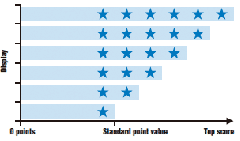
The total points for the test results of the full-wrap, offset, and side collision tests calculated for the driver's seat and the full-wrap and side collision (driver's or the front passenger's seat results are used) tests calculated for the front passenger's seat are each displayed in a bar graph.
In addition, in order to accurately differentiate the evaluations of each vehicle, base point values are set based on what vehicles with today's technology are believed capable of achieving (16 points out of 36 for the driver's seat and 12 points out of 24 for the front passenger's seat). Vehicles which score below these standard point values are given one star and vehicles which have scores which fall between the standard point value and top point value are awarded two to six stars, which is calculated by dividing the range from the standard point value to the top point value into ?ve

The safety performance in the case of 0 points is equivalent to the standard safety performance in the case of a test involving a collision speed ten percent greater than that indicated by government safety technical regulations. In the case of offset frontal collision which does not have domestic standard, it is equivalent to the European technical regulations.(The same can be said for the individual test evaluation.)
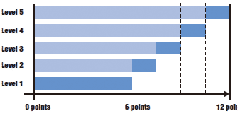
Points for the driver's seat, front passenger's seat and rear passenger's seat are shown in a bar graph. Furthermore, in order to accurately differentiate between the evaluations of different vehicles, a standard is set based on current technology. Up to 6 points out of 12 is given level 1 and the rest of the range is divided up into equal parts, which are respectively assigned to level 2 (more than 6 points but 7.5 or less), level 3 (more than 7.5 points but 9 or less), level 4 (more than 9 points but 10.5 or less) or level 5 (more than 10.5 points).

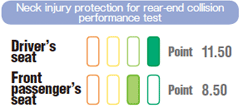
Four-color coding and points out of 12 are shown according to the driver's seat and front passenger's seat. Furthermore, in order to accurately differentiate between the evaluations of different vehicles, a standard of neck injury protection for rear-end collision performance is set based on current commercially-available vehicles. Orange represents up to 5 points out of 12 and the rest of the range is divided into three parts; yellow (more than 5 points but 8 or less), light green (more than 8 points but 10 or less) and green (more than 10 points).
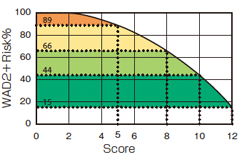
Each color represents an estimated probability of serious neck injury at a residual disability level (WAD2+risk).
In this probability, a standard of neck injury protection performance for rear-end collision is set based on current commercially-available vehicles.
Orange (5 points or less) represents 89% or higher, yellow (more than 5 points but 8 or less) represents 66 to 89%, light green (more than 8 points but 10 or less) represents 44 to 66% and green (more than 10 points) represents 15 to 44%.
Please note that this injury probability is calculated on the basis of injury values when the Dealta V is 17.6km/h (reproduction of collision shocks when a car crushes into a parked car which is the same in mass at a rate of around 32km/h) and the passengers are seated normally and may be different from actual rear-end collision accidents due to differences in collision speed, mass, passenger's posture/physical size and seat's adjustment position.
※WAD: Whiplash Associated Disorders
From FY2008, the side curtain air bag deployment check was added to the side collision test.
